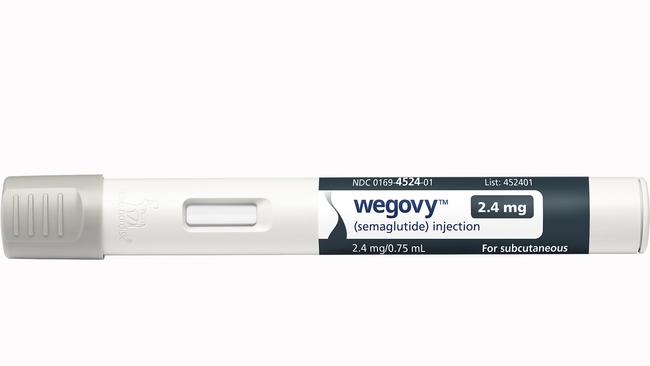Fat-blasting drugs: what your options are
Many of the latest jabs and tabs to fight flab have been approved by the NHS. But be warned: there are pros and cons, including ‘pretty horrific’ side-effects.

Last week Semaglutide, a weight-loss jab marketed as Wegovy, became the latest diet drug to be approved by the National Institute for Health and Care Excellence (Nice) for routine use within the NHS. It won’t be easy to qualify for it via the NHS, though.
“It’s not a lifestyle drug for already slim people who want to lose a few more pounds,” says Dr Duane Mellor, a registered dietician and lead for nutrition and evidence-based medicine at Aston University Medical School. “Semaglutide is intended to be used alongside a diet and exercise programme for people living with higher body weight or obesity to improve their health.”
With all weight-loss medications there can be success in terms of fat lost but that can be accompanied by side-effects, some of which he describes as “pretty horrific”. Here’s what you need to know about how they work:

WEGOVY
What you get: Semaglutide
How it’s taken: Injected weekly into the stomach, thigh or arm with an injection pen similar to an EpiPen. Doses typically start with 0.25mg weekly that’s gradually increased until a higher sustained 2.4mg per week is reached by some people.
How it works: Semaglutide mimics a hormone called glucagon-like peptide-1 (GLP-1) and helps the pancreas release the right amount of insulin when blood sugar levels are high. It also makes you feel full as it slows down stomach emptying and suppresses appetite – you eat less and aren’t plagued by hunger pangs.
A study of almost 2,000 people with obesity published in The New England Journal of Medicine shows that people taking Semaglutide lost 14.9 per cent of their starting body weight over 68 weeks.
Side-effects: In clinical trials on Wegovy people have complained of side-effects including constipation, nausea, vomiting, headaches and diarrhoea. Studies show that people may regain weight once they stop taking the drug.
Best for: It will be recommended for use by people with at least one weight-related health condition (high blood pressure, type 2 diabetes, sleep apnoea or heart issues) as well as those who have a body mass index (BMI) of 30+ - ie near the top of the obese range.

OZEMPIC
What you get: Semaglutide
How it’s taken: A weekly injection into the thigh, arm or stomach with an injection pen, typically starting with a 0.25mg dose that is gradually increased over several months to 1.0mg.
How it works: Similar to Wegovy, but providing Semaglutide in slightly lower doses. It’s apparently the worst-kept weight-loss secret in Hollywood among slimming-obsessed celebrities.
Side-effects: Constipation, nausea, vomiting, headaches and diarrhoea.
Best for: Recommended by Nice to help manage blood glucose levels for those with type 2 diabetes. Not intended as a weight-loss drug.

XENICAL
What you get: 120mg Orlistat
How it’s taken: One tablet with water before, during or up to an hour after each of three daily meals.
How it works: A branded version (Xenical) of the generic drug Orlistat has been shown in trials to prevent up to one third of dietary fat from food being digested by the body.
“It works by inhibiting gastric and pancreatic lipase enzymes that break down fat in the digestive system,” Mellor says. “By preventing these enzymes from working properly, some of the undigested fat is eliminated from the body in stools.” It is typically prescribed for 12 weeks, during which time you might expect to lose up to 5 per cent of your body weight – in most cases that’s about 3-7kg.
Side-effects: “These drugs can cause oily diarrhoea and flatulence,” Mellor says. Other potential problems include headaches, anxiety and menstrual disturbances (nice.org.uk). Concerns about liver damage were raised a few years ago, although Nice says “the benefits of Orlistat outweigh the risks”. Still, it advises people to seek medical attention if they notice yellowing skin and eyes, itching, dark-coloured urine and liver tenderness, all signs of liver complications. Because it can lower the levels of fat-soluble vitamins A, D, E and K absorbed by your body, users are recommended to take a multivitamin containing these nutrients.
Best for: People with a BMI 28+ with associated risk factors such as high blood pressure. Guidance from Nice is that treatment should only be continued after three months if people initially lose 5 per cent of their body weight in those first 12 weeks.

ALLI
What you get: 60mg Orlistat
How it’s taken: One capsule taken with water three times a day, with each meal containing fat.
How it works: An over-the-counter (OTC) Orlistat product with lower amounts than the prescription drugs, it absorbs approximately 25 per cent of the fat from food.
Side-effects: Commonly reported ones include weakness and stomach pain as well as oily diarrhoea and the stomach issues associated with Orlistat. It should not be taken for longer than six months at a time. It is not cheap - a month’s supply at boots.com is £55 ($100).
Best for: Alli is recommended for use by people with a BMI of 28+. Although it is OTC you will still need to have a consultation with a pharmacist (online or in person) before taking it.
SAXENDA
What you get: Liraglutide
How it’s taken: Injected daily, starting with 0.6mg, increasing to up to 3mg.
How it works: Liraglutide mimics the action of the hormone GLP-1 that is released when we eat and acts as a physiological regulator of appetite.
“It basically makes you feel more full and less hungry,” Mellor says. A New England Journal of Medicine study showed that one in three people with obesity who used Saxenda in conjunction with a reduced-calorie diet and exercise lost more than 10 per cent of their body weight (an average of 10kg) in 56 weeks.
And in a JAMA analysis that compared a range of diet drugs, Liraglutide was associated with the highest odds of achieving at least 5 per cent weight loss in a year.
Side-effects: “The fact that it needs to be injected daily is a big downside,” Mellor says. It can also cause headaches, toothache, dizziness, nausea and vomiting for some people. The study showed that, along with Naltrexone-Bupropion (below), it had the highest rates of people stopping because of unwanted side-effects.
Best for: Available on prescription for people with a BMI of 28+ who have other weight-related medical issues or for those with a BMI of more than 30.
MYSIMBA
What you get: Naltrexone-Bupropion
How it’s taken: One tablet daily and increased to a maximum of four daily after a month taken with food.
How does it work: Combines Naltrexone, an opiate antagonist, and Bupropion, an antidepressant, which are thought to work by targeting the central nervous system pathways responsible for hunger and eating. “It chemically changes appetite so that people feel hungry and resist food cravings,” Mellor says. “But it also potentially changes biology to produce unwanted side-effects.”
Side-effects: Possible dizziness, nausea and drowsiness. In the review of diet drugs published in JAMA, Naltrexone-Bupropion was shown to produce an average 5kg weight loss in a year, compared with 5.3kg with Liraglutide and 2.6kg with Orlistat. Nice states that “clinical trial evidence shows that Naltrexone-Bupropion combined with lifestyle measures” are more effective than just diet and exercise alone, but it no longer recommends the drugs because “the long-term effectiveness is unknown”.
Best for: Not available on NHS prescription. Costs about £105 ($190) per month on private prescription from a weight-management specialist or a doctor.
The Times



To join the conversation, please log in. Don't have an account? Register
Join the conversation, you are commenting as Logout